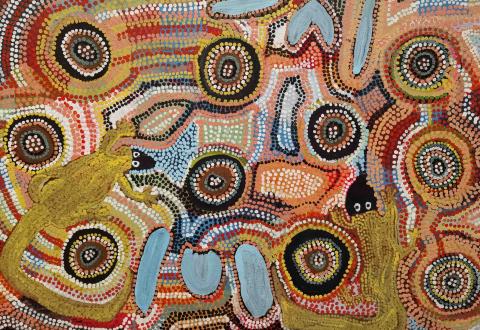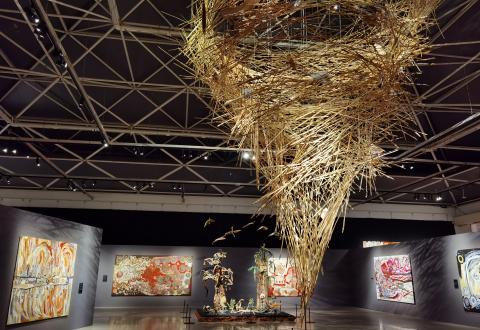From 22 October 2021 to 29 May 2022, the Art & History Museum will be exhibiting Australian Aboriginal art for the first time. The world of the Aboriginals is a wonderful and fascinating universe, filled with secrets for the non-initiated. The First Peoples of Australia are the heirs to the oldest continuous culture in the world, which dates back 65.000 years. However rich, this culture is not expressed in architecture, written texts or artefacts. Today, as in the past, ancestral knowledge is exclusively passed on from one generation to the next by means of an oral tradition centred around...
From 22 October 2021 to 29 May 2022, the Art & History Museum will be exhibiting Australian Aboriginal art for the first time. The world of the Aboriginals is a wonderful and fascinating universe, filled with secrets for the non-initiated. The First Peoples of Australia are the heirs to the oldest continuous culture in the world, which dates back 65.000 years. However rich, this culture is not expressed in architecture, written texts or artefacts. Today, as in the past, ancestral knowledge is exclusively passed on from one generation to the next by means of an oral tradition centred around rituals and ceremonies, in which the concept of ‘Dreamings’ or ‘Dreamtime’ plays a vital role.

Live the Dream Time
‘Dreamtime’ is a mythical time in which ancestral spirits such as the Tingari, the Seven Sisters, and the Rainbow Serpent created the earth, the plants, the animals, the people, the water and the stars. ‘Dreamings’ refer to these spirits, as well as their travels throughout the land and their acts of creation. However, Aborignal ‘Dreamtime’ has nothing to do with the Western concept of time. It is a time outside time, an everywhen, in which creation is at once past, present and future.

Before Time Began explores the Dreamings and the creation of the earth but also focuses on the birth of contemporary art. The main part of the exhibition presents traditional bark paintings starting from the 1950s, made with natural pigments and originating in Arnhem Land; paintings and sculptures from the 1970s which emerged from the desert regions with the Western Desert art movement, in which artists experimented with bright industrial paint on canvas and wood panels; as well as more recent, at times monumental, creations by various contemporary artists or art collectives. Two short films...
Before Time Began explores the Dreamings and the creation of the earth but also focuses on the birth of contemporary art. The main part of the exhibition presents traditional bark paintings starting from the 1950s, made with natural pigments and originating in Arnhem Land; paintings and sculptures from the 1970s which emerged from the desert regions with the Western Desert art movement, in which artists experimented with bright industrial paint on canvas and wood panels; as well as more recent, at times monumental, creations by various contemporary artists or art collectives. Two short films feature a group of male artists and a group of female artists collaborating. While they’re painting, they tell each other stories, sing, laugh and dance together. Even though certain aspects remain hidden for the non-initiated, the paintings reveal ancient mythical stories and display a strong connection with their natural surroundings.

One of the exhibition’s eye-catchers is the installation Kulata Tjuta (Many Spears), created by a group of artists of all ages from several art centres across the APY Lands (Anangu Pitjantjatjara Yankunytjatjara). The work is made up of one thousand five hundred spears and represents a kupikupi – a funnel-shaped dust storm like those seen in the desert regions. A spear goes straight to its target, whereas a whirlwind travels in a random direction. A kupi kupi travels through time (from the ancestral past, through colonisation, to the present day) and picks up a lot of elements on its...
One of the exhibition’s eye-catchers is the installation Kulata Tjuta (Many Spears), created by a group of artists of all ages from several art centres across the APY Lands (Anangu Pitjantjatjara Yankunytjatjara). The work is made up of one thousand five hundred spears and represents a kupikupi – a funnel-shaped dust storm like those seen in the desert regions. A spear goes straight to its target, whereas a whirlwind travels in a random direction. A kupi kupi travels through time (from the ancestral past, through colonisation, to the present day) and picks up a lot of elements on its whimsical path. It is at once a manifestation of the soul of a deceased person, and a metaphor for today’s society and its uncertain future.

The final part of the exhibition presents the work of contemporary photographer and artist Michael Cook. Cook reflects on the idea of civilisation. In the series of photographs entitled Civilised, for instance, he portrays Australian Aboriginals dressed in the historical attire of the European powers that visited Australia in the early day of colonisation.

Before Time Began is part of the Royal Mission of the Royal Museums of Art and History (RMAH) to spark wonder and curiosity in Brussels, the heart of Europe, for the worlds created by women and men. The RMAH offer democratising, inclusive and polyphonic spaces to foster a critical dialogue about past and future. They strive towards deeper insights into cultures and societies and encourage all of us to take better care of the world by allowing us to imagine another world as well. This exhibition is a concept of Fondation Opale in Lens (Switzerland), Europe’s most important centre for Aboriginal art and culture. The works presented in Before Time Began, most of which belong to this collection, originated in remote areas of Australia and have been treated in an ethically responsible way.
Buy your ticket















